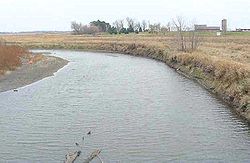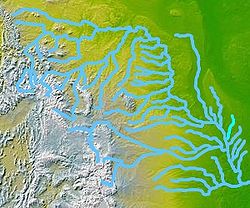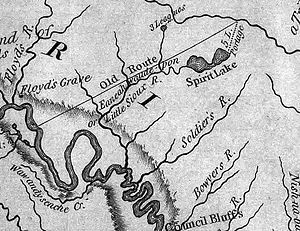
Little Sioux River
Encyclopedia



River
A river is a natural watercourse, usually freshwater, flowing towards an ocean, a lake, a sea, or another river. In a few cases, a river simply flows into the ground or dries up completely before reaching another body of water. Small rivers may also be called by several other names, including...
in the United States
United States
The United States of America is a federal constitutional republic comprising fifty states and a federal district...
. It rises in southwest Minnesota
Minnesota
Minnesota is a U.S. state located in the Midwestern United States. The twelfth largest state of the U.S., it is the twenty-first most populous, with 5.3 million residents. Minnesota was carved out of the eastern half of the Minnesota Territory and admitted to the Union as the thirty-second state...
near the Iowa
Iowa
Iowa is a state located in the Midwestern United States, an area often referred to as the "American Heartland". It derives its name from the Ioway people, one of the many American Indian tribes that occupied the state at the time of European exploration. Iowa was a part of the French colony of New...
border, and continues to flow southwest for 258 miles (415.2 km) across northwest Iowa into the Missouri River
Missouri River
The Missouri River flows through the central United States, and is a tributary of the Mississippi River. It is the longest river in North America and drains the third largest area, though only the thirteenth largest by discharge. The Missouri's watershed encompasses most of the American Great...
at Little Sioux
Little Sioux, Iowa
Little Sioux is a city in Harrison County, Iowa, United States. The population was 217 at the 2000 census. The city is most known for Little Sioux Scout Ranch of the Boy Scouts of America.-Geography:Little Sioux is located at ....
. The Little Sioux River was known as Eaneah-waudepon or "Stone River" to the Sioux Indians. Its tributaries include the Ocheyedan River
Ocheyedan River
The Ocheyedan River is a tributary of the Little Sioux River, 58 mi long, in southwestern Minnesota and northwestern Iowa in the United States. Via the Little Sioux and Missouri Rivers, it is part of the watershed of the Mississippi River...
, Maple River
Maple River (Iowa)
The Maple River is a river in the United States. It flows through western Iowa and is long. The Maple River rises in Buena Vista County, and flows generally southwest through Ida Grove, Battle Creek, Danbury, and Mapleton finally joining with the Little Sioux River near Turin. Much of the river...
and the West Fork of the Little Sioux River
West Fork of the Little Sioux River
West Fork of the Little Sioux River is a river in the United States. Approximately long, it courses through northwest Iowa, rising north of Marcus in Cherokee County and flowing generally southwest through farmland in Plymouth and Woodbury counties until the meandered streambed finally meets the...
. The Little Sioux River is integral to the Nepper Watershed Project, a major Iowa flood control
Flood control
In communications, flood control is a feature of many communication protocols designed to prevent overwhelming of a destination receiver. Such controls can be implemented either in software or in hardware, and will often request that the message be resent after the receiver has finished...
and soil conservation
Soil conservation
Soil conservation is a set of management strategies for prevention of soil being eroded from the Earth’s surface or becoming chemically altered by overuse, acidification, salinization or other chemical soil contamination...
program that was introduced in 1947.
The Little Sioux Valley was important in the Spirit Lake Massacre
Spirit Lake Massacre
The Spirit Lake Massacre was an attack by a Wahpetuke band of Santee Sioux on scattered Iowa frontier settlements during a severe winter. Suffering a shortage of food, the renegade chief Inkpaduta led 14 Sioux against the settlements near Okoboji and Spirit lakes in the northwestern territory of...
of 1857, when the Santee Sioux chief Inkpaduta
Inkpaduta
Inkpaduta was a war chief of the Santee Sioux during the 1857 Spirit Lake Massacre and the 1862 Dakota War against the United States Army in Minnesota and the Dakota Territory.-Early life:Inkpaduta was born in what later became the Dakota...
made forays as far downstream as Smithland
Smithland, Iowa
Smithland is a city in Woodbury County, Iowa, United States. It is part of the Sioux City, IA–NE–SD Metropolitan Statistical Area. The population was 221 at the 2000 census.-Geography:Smithland is located at ....
. The river valley also figures prominently in folklore about the nineteenth century outlaw, Jesse James, who reportedly used the secluded valley, with its wooded ravines, as a hideout and a route north to Minnesota during the 1870s.
Geologically, the Little Sioux rises in a region of glacial potholes near the "Iowa Great Lakes
Iowa Great Lakes
The Iowa Great Lakes are a group of natural glacial lakes in Dickinson County in northwestern Iowa in the United States. The three principal lakes of the group are Spirit Lake, West Okoboji Lake, and East Okoboji Lake. They are the largest natural lakes in the state of Iowa. The largest, Spirit...
" (Spirit Lake
Spirit Lake (Iowa)
Big Spirit Lake is a natural body of water, approximately in area, in Dickinson County in northwest Iowa in the United States. It is part of the chain of lakes known as the Iowa Great Lakes, the northern shore of the lake straddles the border with Minnesota. It is the largest natural lake in Iowa....
, and East and West Okoboji
Iowa Great Lakes
The Iowa Great Lakes are a group of natural glacial lakes in Dickinson County in northwestern Iowa in the United States. The three principal lakes of the group are Spirit Lake, West Okoboji Lake, and East Okoboji Lake. They are the largest natural lakes in the state of Iowa. The largest, Spirit...
). It then traverses a rich agricultural region on its way to the Loess Hills
Loess Hills
The Loess Hills are a formation of wind-deposited loess soil in the westernmost part of Iowa and Missouri along the Missouri River.-Geology:The Loess Hills are generally located between 1 and east of the Missouri River channel...
, from which it then flows out onto the floodplain of the Missouri River. Through much of its middle course (i.e., from Linn Grove
Linn Grove, Iowa
Linn Grove is a city in Buena Vista County, Iowa, United States. The population was 211 at the 2000 census. The nearby Chan-Ya-Ta Site contains the remains of a 1000-year-old prehistoric village and is on the National Register of Historic Places.-Geography:...
to Smithland
Smithland, Iowa
Smithland is a city in Woodbury County, Iowa, United States. It is part of the Sioux City, IA–NE–SD Metropolitan Statistical Area. The population was 221 at the 2000 census.-Geography:Smithland is located at ....
) the Little Sioux is a relatively wild meandered stream, with excellent canoeing, camping, and fishing opportunities. However, from Smithland downstream to its mouth, the river has been channelized and environmentally degraded.
Flooding of the river is common in early to late spring, as the often-heavy winter snow melts. This has resulted in riparian woodlands of cottonwood trees adjacent to fertile farm ground on the bottomlands. Correspondingly, hunters are rewarded with a bounty of white-tailed deer
White-tailed Deer
The white-tailed deer , also known as the Virginia deer or simply as the whitetail, is a medium-sized deer native to the United States , Canada, Mexico, Central America, and South America as far south as Peru...
, rabbits and pheasants
Common Pheasant
The Common Pheasant , is a bird in the pheasant family . It is native to Georgia and has been widely introduced elsewhere as a game bird. In parts of its range, namely in places where none of its relatives occur such as in Europe , it is simply known as the "pheasant"...
during the fall hunting season.
Fishing opportunities are best in late spring after flood waters have dissipated. Edible gamefish such as bullhead
Black bullhead
The black bullhead, Ameiurus melas, is a species of bullhead catfish. Like other bullhead catfish, it has the ability to thrive in waters that are low in oxygen, brackish, turbid and/or very warm. It also has barbels located near its mouth, a broad head, spiny fins and no scales...
and channel catfish
Channel catfish
Channel catfish, Ictalurus punctatus, is North America's most numerous catfish species. It is the official fish of Missouri, Iowa, Nebraska, Kansas, and Tennessee, and is informally referred to as a "channel cat". In the United States they are the most fished catfish species with approximately 8...
are frequently caught with nothing more than a hook and worm, with northern pike
Northern Pike
The northern pike , is a species of carnivorous fish of the genus Esox...
, walleye
Walleye
Walleye is a freshwater perciform fish native to most of Canada and to the northern United States. It is a North American close relative of the European pikeperch...
, and shovelnose sturgeon
Shovelnose sturgeon
The shovelnose sturgeon, Scaphirhynchus platorynchus, is the smallest species of freshwater sturgeon native to the United States of America. It is often called "hackleback", "sand sturgeon", or "switchtail." Switchtail refers to the long filament found on the upper lobe of the caudal fin...
also available.

